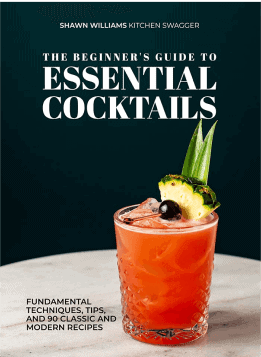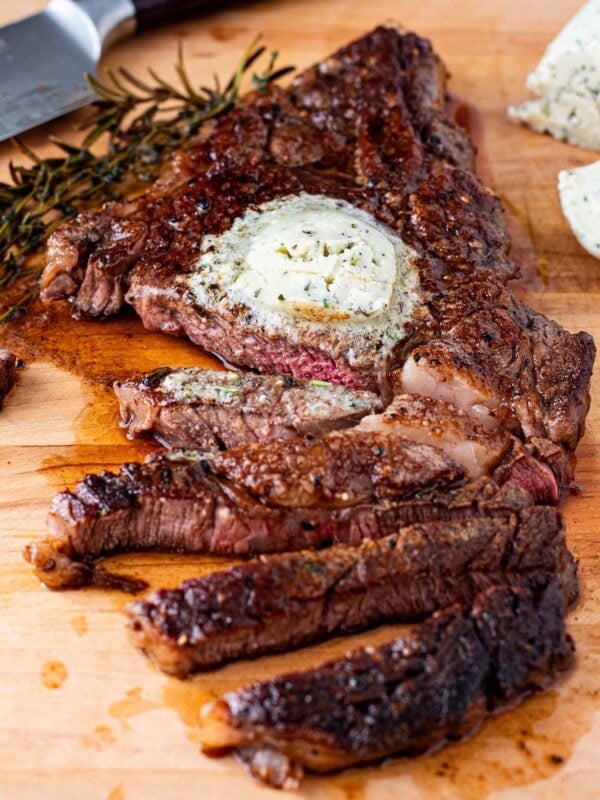This post may contain affiliate links. Please read our disclosure policy.
This pan-seared filet mignon recipe is so easy to master and renders perfect filet mignon every single time! While there are plenty of ways to cook tenderloin steak, this technique is the easiest and most repeatable. If you go out to a nice steakhouse then this is most likely the method they are using to cook your steak.

The secret to cooking the perfect steak is combining pan searing with an oven finish. This gives you a nicely seared exterior (high heat) with a juicy and evenly cooked interior (indirect lower heat). A cast iron skillet allows you to easily transfer your steak from the stovetop to the oven, making this a simple recipe to master.
The overall consistency and predictability of this cooking technique give this recipe a very high success rate on the very first try. I’ve followed it to the T with great success with hundreds of steaks. If this is your first time preparing filet mignon or if you’re struggling to get it right, then this recipe is for you.
I highly recommend you also check out my blueberry glazed filet mignon, balsamic glazed filet mignon, and bacon-wrapped filet mignon. If you’re looking for a good steak to share with a crowd, look no further than my porterhouse steak recipe with dipping sauces or my surf and turf recipe for two! Also, see reverse searing or grilling filet mignon.
Table of Contents
Ingredient Notes and Substitutions

- 10-12 ounce tenderloin beef filets (roughly 1.5- 2 inches thick): look for steaks that are about 2 inches thick and appear plump and deep red in color. Avoid steaks with signs of browning or slimy texture.
- Salt and pepper: for seasoning and optional dry brining.
- Vegetable or canola oil: these oils are best for searing because they have a higher smoke point than butter or olive oil.
See the recipe card for full information on ingredients and quantities below.
Dry Brining Steak
Dry brining is the process of drying the exterior of the steak with salt before cooking, locking in the juices, and enhancing the flavor. To dry brine steak, place the steaks on a wire rack set on a baking sheet and season liberally with coarse sea salt or kosher salt, and pepper.
Place the steaks in the fridge uncovered for a few hours at a minimum but preferably overnight. The drier steak exterior will improve the sear and make for a better-textured crust. Steak should always rest on the counter for at least 30-45 minutes before cooking to climatize. No additional salt or seasoning is required.

Expert Tips
- Precisely timing your cooking time for steak always yields consistent results. Use a timer for each side on the skillet and then in the oven.
- If you don’t have an oven-safe pan, you can sear your filets on the stovetop and then transfer them to a baking sheet lined with a wire rack. Just note, that this will likely add additional baking time.
- If cooking more than 4 steaks on a standard skillet, you may need to adjust the cooking times to account for heat loss.
- Cooking steaks at high temps in a skillet tends to get smokey. Open a kitchen window and turn on your kitchen’s overhead vent fan before you start to help with ventilation.
- The most important aspect of cooking any steak is the rest period after you take it off the heat. Letting a steak rest for 5-7 minutes redistributes the juices and ensures you hit your final cooking temp.
- Always remove your steak below your final desired serving temp by 5-7 degrees Fahrenheit. Your steak will continue to cook after it’s been removed from the heat.
Steak Temperature Chart
The timing/temperature chart below corresponds to the pan sear/oven method in this recipe. It’s a great guide assuming you choose a steak of similar size and thickness as listed in the recipe. I recommend a digital thermometer to verify your steak’s internal temperature for the desired level of doneness.
| Doneness | Internal Temp | Oven Duration |
|---|---|---|
| Very Rare/rare | 120°F to 125°F | 4 minutes |
| Medium rare | 125°F to 130°F | 5-6 minutes |
| Medium | 135°F to 140°F | 6-7 minutes |
| Medium well | 145°F to 150°F | 8-9 minutes |
| Well done | 160°F and above | 10+ minutes |
More Steak Recipes
Enjoy this recipe? If you made this recipe, please leave a ★ ★ ★ ★ ★ star rating in the recipe card below & a review in the comments!
Filet Mignon

Ingredients
- 4, 10 ounce thick tenderloin beef filets, roughly 1.5- 2 inches thick
- salt and pepper to taste
- 1 tablespoon vegetable or canola oil, can use 1 tbsp butter but it has a lower smoke point
Garlic & Herb Butter
- 1/2 stick of butter, softened
- 1 tablespoon chopped fresh rosemary
- 1 tablespoon chopped fresh tarragon
- 1/2 tablespoon minced garlic
Instructions
For the herb butter
- Leave the butter on the counter to soften or place it in a microwave-safe bowl and microwave until malleable, 10-15 seconds. Use a fork to mash in the herbs and garlic until fully mixed. Store in the refrigerator and remove 10 minutes before adding to the filet.
For the filets
- Preheat the oven to 415°F. Remove the steak from the fridge 30 minutes prior to cooking, this is to bring the steak to room temperature and ensure your cooking times are more accurate. Season all sides liberally with salt and pepper. This can be done while your steak comes to room temp.
- Add 1 tablespoon of oil (all you need is a very light coating) to an oven-safe cast iron skillet and turn the heat up high, allowing the skillet to become very hot. Twirl the pan to distribute oil as it heats. Once the oil starts to smoke, place the filets face down and sear undisturbed for 2 minutes. Flip the filets and sear for an additional 2 minutes. This will give your filets a nice seared edge.
- Optionally add some herb butter and a whole garlic clove/herbs to the pan before transferring it to the oven. The butter will melt and the herbs will season the pan drippings for a later step. Transfer your skillet directly to the oven. [WARNING] skillet may be hot, handle it with oven mitts. For rare, bake for 4 minutes. Medium rare, 5-6 minutes. Medium, 6-7 minutes. Medium well, 8-9 minutes. Remember, depending on the size of the steak, the more or less time it will take. This recipe is ideal for an 8-10 ounce portion, roughly 1.5-2 inches thick.
- Optionally spoon some of the seasoned pan drippings over the steak to infuse it with extra flavor.
- Remove filets from the skillet and set them on a plate and let sit for 5-10 minutes before serving. This is important to bring your steak to its final serving temperature.
- Top with a slice of garlic and herb butter and serve.
Notes
Rare: 120°F to 125°F
Medium rare: 125°F to 130°F
Medium: 135°F to 140°F
Medium well: 145°F to 150°F
Well done: 160°F and above
Nutrition
Nutrition information is automatically calculated, so should only be used as an approximation.



















This is an easy and fool proof method to delicious beef tenderloin! I won’t do it any other way now! Thank you!
This will be the 3rd year in a row that I’ve used this recipe to cook our Valentines Day Dinner and haven’t been disappointed!!! Great tips and suggestions. Thank you for an amazing recipe!!
I hope I am not too late to ask this question : My filet’s are exactly 2 inches thick. Do I need to make any oven adjustments? I plan on searing 2 min each side..baking for 7 (three in a skillet). These baby’s were expensive and I hate to ruin them!
Trying tonight! Just curious if the cooking time changes if only cooking a single filet opposed to the 4 listed in recipe
You should be golden with 4
We are iced in here in Texas and I wanted to try something I’ve never done before (I’m 59) and ran across this recipe.
WE LOVE IT!!!! I used my own seasonings but followed your instructions and they turned out PERFECT! I even learned how to cook and get the desired temperature of our steaks. My husband likes Medium and I like Medium Well.
Thank you SO much!
Wanda
Omg – this was amazing! I timed it all just like you said and the filets were perfect.
Can’t wait to try this! Because I’ll be cooking for a larger crowd (8 people), I’ll need to pan-sear two times. Can I sear one batch, move it to a cookie sheet, sear the next batch, move to a cookie sheet, and then put the cookie sheet in the over for suggested time? Or does the cast iron perform some magic when it’s in the oven vs having the steaks cook on a cookie sheet? Thanks!
Renee, from past experience I would say avoid the cookie sheet to finish the steaks in the oven if you can. The heat conduction and retention of cast iron is so much better – you will definitely see and taste a difference. Would it be possible to borrow a 2nd pan from a friend?
It’s a good recipe but it’s no substitute for a properly grilled filet.
Don’t get me wrong, it’s good when the grill is not available but my grilled steaks put this to absolute shame.
Sounds like you and I are about to have a cook off.
Love your reply!!
Literally perfect. I followed it exactly and didn’t substitute (though I’m a pretty good cook, I’ve been told, so I’m always tempted to alter it to my liking). I don’t often cook steak but my sister received a gift of Filet Mignon from Omaha Steaks and asked me to cook it for New Year’s Eve. No pressure there! I made the butter the day before and put it in the fridge (oh maybe one change as I only rosemary and minced garlic). I followed the rest exactly, including using a cast iron skillet, timing the searing and oven cooking, then allowing it to rest afterward, and it was delicious. This recipe made me the hero of New Year’s Eve dinner. Thank you!
It might be helpful to include tips on how to pan sear without setting off your smoke detectors. I will admit, I’m an amateur but I followed the directions to the tee. I even used grapeseed oil which I was told has a lower smoke point. Not in this case. I don’t know if the problem was that I have an electric stove. Maybe high heat isn’t the way to go on one? It was an awful experience and the steak didn’t turn out restaurant quality. Probably because it sat while I was trying to clear the smoke from the room and get the smoke detectors to stop. My dog is traumatized and I’m hoping my hearing will return to normal in a few days. Needless to say, without better instructions I won’t be trying to sear anything in the near future.
There’s no way to avoid the smoke, unfortunately. I put a note in the notes section and also in the post body warning about the smoke and how to prepare for it.
Thank you so much! Part of my problem may be that I live in a townhouse and may never be able to ventilate it enough to handle the smoke. And I’m an amateur. My next place will have a gas stove with an exhaust hood.